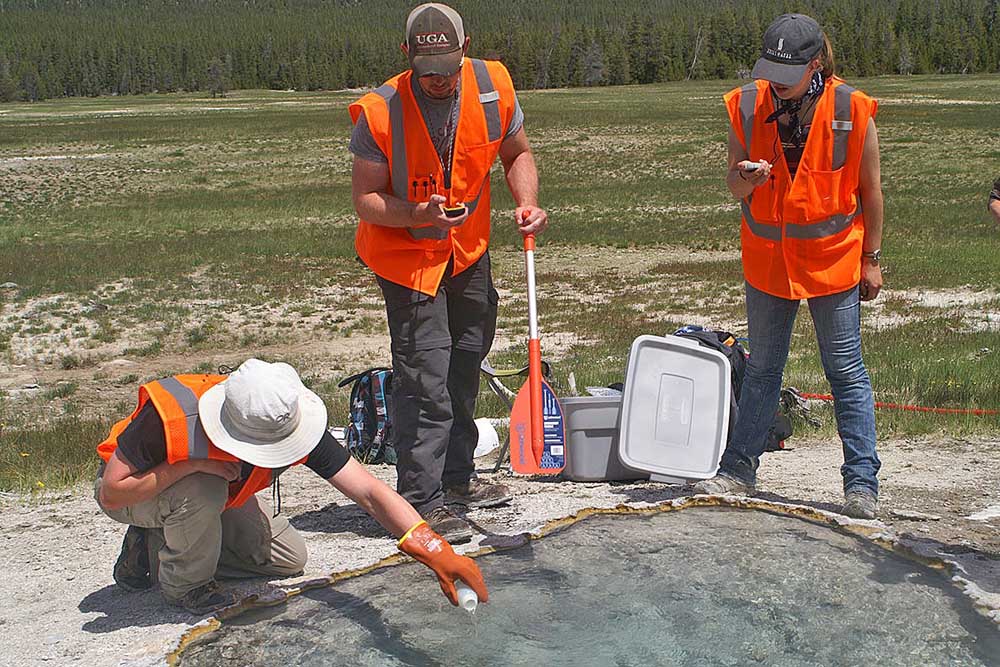Researchers seek info on Yellowstone’s supervolcano
Published 12:00 am Thursday, June 14, 2018

- Washington State University researchers “spike” a Yellowstone hot spring with deuterium, a stable isotope, to calculate how fast magma is recharging beneath the Yellowstone supervolcano.(Photo by Washington State University)
In one of the most low-tech experiments conducted in Yellowstone National Park in recent years, researchers used a small flask of hydrogen-rich water, a collapsible canoe paddle and stop watches to test a theory about measuring how fast the magma below the supervolcano is recharging.
The complicated part of the research was all the mathematical calculations.
“What we want to do is understand what is driving the magmatism at Yellowstone’s caldera,” said Peter Larson, a professor in Washington State University’s School of Environment who co-authored the recently published research in the journal Geosphere.
“Yellowstone is actively driven by basalt that enters the crust from the mantle,” he explained.
The amount of basalt that feeds the system provides the material that can melt the earth’s crust and produce an eruption — or as Larson phrased it in a WSU press release, the basalt magma is the “coal in the furnace that’s heating things up.”
Larson was quick to point out, however, that the research is “not going to tell you when Yellowstone is going to erupt.” The supervolcano last blew about 640,000 years ago, creating the current Yellowstone Caldera — the huge 30-by-45-mile crater left after the eruption.
“The article made it sound more complicated than it actually is,” said Jerry Fairley, a University of Idaho professor of Geological Sciences.
Fairley explained that it is pretty common knowledge that Yellowstone is a very large hydrothermal system — another way of saying there’s a lot of hot water just under the Earth’s crust in the park. One research paper described it as “one of the most focused heat sources on Earth,” with magma circulating only 5 to 10 miles underground.
Many of the main attractions in the park are driven by that hydrothermal activity, such as Old Faithful Geyser. As the research paper noted, more than 10,000 geysers, mud pots, fumaroles and thermal springs are spread across the park interior. It’s interesting to note that those thermal features are concentrated at the edges of the more recent Elephant Back, Mallard Lake, and Nez Perce lava flows that have effectively acted as caps, blocking the thermal features from surfacing.
With hot magma so close to the surface in places like Yellowstone, the researchers were attempting to calculate how much heat four different springs in the Morning Mist area of the Lower Geyser Basin were releasing.
“Heat out the top has to equal heat at the bottom,” Larson said. “The estimate we have is a very minimal estimate. There are some things we can’t account for.”
Those other things would include how much heat is dissipated through the earth, which Fairley said could be twice as much heat as is dispersed through hydrothermal features. Groundwater can also move heat around, concentrating it in some areas.
To make their calculations the scientists poured deuterium, a stable isotope of hydrogen, into the four hot springs one at a time. The paddle was used to mix in the solution. The stop watches timed how long it took for the deuterium to dissipate. The temperature of the hot springs also figured into the calculation of water and heat flowing out of the springs.
Interestingly, the hot water seems to be coming from groundwater deposited during the Pleistocene era, a period of repeated glaciation between 2.5 million and 11,700 years ago. Scientists can tell this based on the water’s chemical signature.
“We’re finding that, if you extrapolate the data, about half of the amount of magma is coming up under Yellowstone as is coming up under Kilauea, Hawaii,” Fairley said in a press release, referring to the erupting Hawaiian volcano.
Although the research is meant to gain a better understanding of what’s going on with magma flows and to gain insight into the factors that cause the supervolcano’s eruption, hydrothermal explosions are “among the most significant hazards” in the popular park that last year hosted more than 4.1 million people. That’s according to the 2014 article “Dynamics of the Yellowstone hydrothermal system,” written by scientists Shaul Hurwitz and Jake Lowenstern, former lead scientist for the Yellowstone Volcano Observatory.
“At least 20 large hydrothermal explosion craters with dimensions ranging between 100 and 2,800 meters in diameter, and numerous smaller craters have developed within the Yellowstone Caldera and along the Norris-Mammoth corridor over the past 16,000 years,” they write.
“Rock fragments were ejected at least as far as (2 to 2.5 miles) from the Mary Bay crater rim (about) 13,600 years ago, and fragments from the Indian Pond explosion crater are found as far as (1.8 miles) from the vent.”
Magma entering the hydrothermal system may also increase pressure that results in deformation in the caldera’s surface, or uplifting, as well as cause earthquakes. In turn, those earthquakes may be a way that pressure is released from the system.
“With Yellowstone, everything is an estimate,” Fairley said. “It’s such a huge system that it’s hard to pin down.”
The lead author of the paper was WSU graduate student Nick McMillan. Other researchers were WSU graduate student Joe Mulvaney-Norris and University of Idaho graduate research assistant Cary Lindsey.






